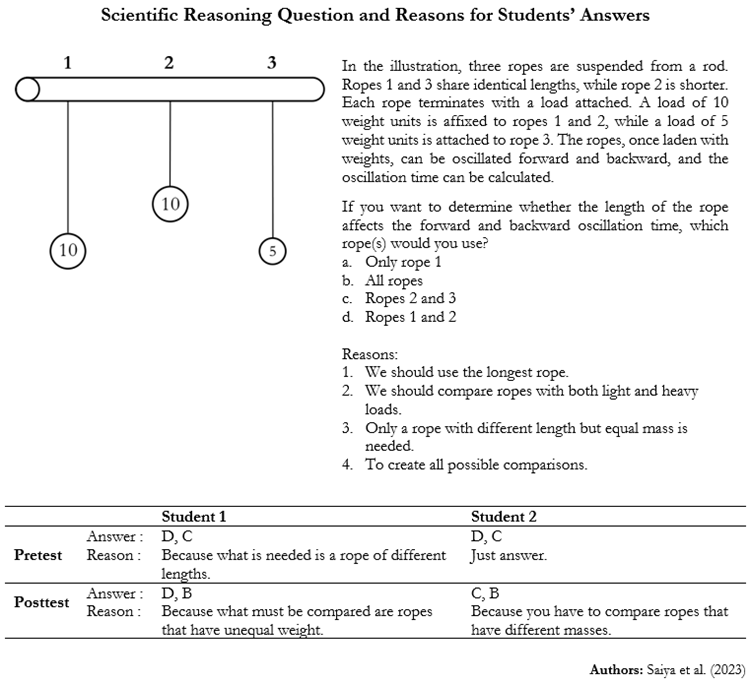
Study of Scientific Reasoning and Concept Mastery of Students Through Guided Inquiry Learning Model Assisted by Formative Assessment
Abstract
This study endeavors to assess the impact of guided inquiry learning, complemented by formative assessment, on students’ scientific reasoning (SR) and concept mastery (CM). The research involved 20 students from class XI A at SMA Muhammadiyah 02 Sumberpucung, utilizing questions adapted from the modified Lawson classroom test of scientific reasoning (MLCTSR) to measure SR, and the force concept inventory (FCI) to gauge CM. The instructional focus was Newton’s law of motion. Both qualitative and quantitative analyses were employed for data interpretation. The findings revealed a substantial influence of the guided inquiry learning model on SR, with a d-effect size value of 3.829. Similarly, students’ CM exhibited a noteworthy impact, evidenced by a d-effect size value of 3.099. These values signify that both SR and CM fall within the category of greater than the standard effect size. The outcomes imply a significant enhancement in students' proficiency in both SR and CM as a result of the guided inquiry learning approach.
Keywords
Full Text:
PDFReferences
Black, P., & Wiliam, D. (2009). Developing the theory of formative assessment. Educational Assessment, Evaluation and Accountability (formerly: Journal of personnel evaluation in education), 21, 5–31. https://doi.org/10.1007/s11092-008-9068-5
Creswell, J. W., & Sinley, R. C. (2017). Entwicklung eines kulturspezifischen gemischten Methodenansatzes zur globalen Forschung. KZfSS Kölner Zeitschrift für Soziologie und Sozialpsychologie, 69, 87–105. https://doi.org/10.1007/s11577-017-0453-2
Daryanti, E. P., Rinanto, Y., & Dwiastuti, S. (2015). Peningkatan kemampuan penalaran ilmiah melalui model pembelajaran inkuiri terbimbing pada materi sistem pernapasan manusia. Jurnal Pendidikan Matematika dan Sains, 3(2), 163–168. http://dx.doi.org/10.21831/jpms.v6i2.10948
Dawson, K. S., Kneib, J. P., Percival, W. J., Alam, S., Albareti, F. D., Anderson, S. F., ... & Zou, H. (2016). The SDSS-IV extended baryon oscillation spectroscopic survey: overview and early data. The Astronomical Journal, 151(2), 44. https://doi.org/10.3847/0004-6256/151/2/44
Docktor, J. L., & Mestre, J. P. (2014). Synthesis of discipline-based education research in physics. Physical Review Special Topics-Physics Education Research, 10(2), 020119. https://doi.org/10.1103/PhysRevSTPER.10.020119
Efendi, R. (2011). Kajian penguasaan konsep dan kemampuan inkuiri siswa pada konsep Hukum Newton tentang gerak melalui model pembelajaran learning cycle dengan tiga teknik hands-on. In Kismiantini et al. (Eds.), Pemantapan keprofesionalan peneliti, pendidik, dan praktisi MIPA untuk mendukung pembangunan karakter bangsa. Proceedings of the Seminar Nasional Penelitian, Pendidikan dan Penerapan MIPA, Fakultas MIPA, Universitas Negeri Yogyakarta (pp. 147–162). Yogyakarta, Indonesia.
Handhika, J. (2010). Pembelajaran fisika melalui inkuiri terbimbing dengan metode eksperimen dan demonstrasi ditinjau dari aktivitas dan perhatian mahasiswa. Jurnal Penelitian Pembelajaran Fisika, 1(1), 9–23. https://doi.org/10.26877/jp2f.v1i1/april.104
Hestenes, D., Wells, M., & Swackhamer, G. (1992). Force concept inventory. The physics teacher, 30(3), 141–158. https://doi.org/10.1119/1.2343497
Johnson, C. I., & Mayer, R. E. (2009). A testing effect with multimedia learning. Journal of Educational Psychology, 101(3), 621–629. https://doi.org/10.1037/a0015183
Karmila, D. D., Supeno, S., & Subiki, S. (2019). Keterampilan inkuiri siswa SMA dalam model pembelajaran inkuiri berbantuan virtual laboratory. Jurnal Pembelajaran Fisika, 8(3), 151–158. https://doi.org/10.19184/jpf.v8i3.15218
Khoirina, M., & Cari, C. (2018). Identify students’ scientific reasoning ability at senior high school. Journal of Physics: Conference Series, 1097(1), 012024. https://doi.org/10.1088/1742-6596/1097/1/012024
Kurniawati, I. D., & Diantoro, M. (2014). Pengaruh pembelajaran inkuiri terbimbing integrasi peer instruction terhadap penguasaan konsep dan kemampuan berpikir kritis siswa. Jurnal Pendidikan Fisika Indonesia, 10(1), 36–46. https://doi.org/10.15294/jpfi.v10i1.3049
Loverude, M. E., Gonzalez, B. L., & Nanes, R. (2011). Inquiry-based course in physics and chemistry for preservice K-8 teachers. Physical Review Special Topics-Physics Education Research, 7(1), 010106. https://doi.org/10.1103/PhysRevSTPER.7.010106
Marsandi, M., Kusairi, S., & Suwono, H. (2016). Pengembangan video remediasi sebagai tindak lanjut feedback asesmen formatif pada materi cahaya dan alat optik. Edu Sains: Jurnal Pendidikan Sains dan Matematika, 4(2), 122–135. https://doi.org/10.23971/eds.v4i2.515
Nojiri, S. I., & Odintsov, S. D. (2007). Introduction to modified gravity and gravitational alternative for dark energy. International Journal of Geometric Methods in Modern Physics, 4(01), 115–145. https://doi.org/10.1142/S0219887807001928
Puspita, D. I. (2016). Analisis tingkat kemampuan scientific reasoning siswa SMA kelas X IPA se-Kota Tegal. Reorientasi bioteknologi dan pembelajarannya untuk menyiapkan generasi Indonesia emas berlandaskan entrepreneurship. Proceedings of the Seminar Nasional Sains dan Entrepreneurship III Tahun 2016 (pp. 198–205). Semarang, Indonesia.
Shilla, R. A. (2018). Analisis penguasaan konsep Hukum Newton tentang gerak dan scientific reasoning siswa pada pembelajaran Fisika disertai formative assesment (Doctoral dissertation, Universitas Negeri Malang, Malang, Indonesia). Retrieved from https://repository.um.ac.id/59929/
Suma, K. (2010). Efektivitas pembelajaran berbasis inkuiri dalam peningkatan penguasaan konten dan penalaran ilmiah calon guru fisika. Jurnal Pendidikan dan Pengajaran, 43(6), 47–55.
Sundari, P. D., & Rimadani, E. (2020). Peningkatan penalaran ilmiah siswa melalui pembelajaran guided inquiry berstrategi scaffolding pada materi suhu dan kalor. Jurnal Eksakta Pendidikan (JEP), 4(1), 34–41. https://doi.org/10.24036/jep/vol4-iss1/402
Tayubi, Y. R. (2005). Identifikasi miskonsepsi pada konsep-konsep fisika menggunakan Certainty of Response Index (CRI). Mimbar Pendidikan, 3(24), 4–9.
Waldrip, B., Rodie, F., & Sutopo, S. (2014). The implications of culture for teachers’ use of representations. In B. Eilam & J. K. Gilbert (Eds.), Science teachers’ use of visual representations (pp. 171–193). Cham, Switzerland: Springer Cham. https://doi.org/10.1007/978-3319-06526-7_8
Wijayanti, P. I., & Hindarto, N. (2010). Eksplorasi kesulitan belajar siswa pada pokok bahasan cahaya dan upaya peningkatan hasil belajar melalui pembelajaran inkuiri terbimbing. Jurnal Pendidikan Fisika Indonesia, 6(1), 1–5. https://doi.org/10.15294/jpfi.v6i1.1093
Jurnal Pendidikan Sains Journal of Science, Mathematics, and Vocational Education Graduate School Of Universitas Negeri Malang JPS is licensed under Creative Commons Attribution-ShareAlike 4.0 International License |






